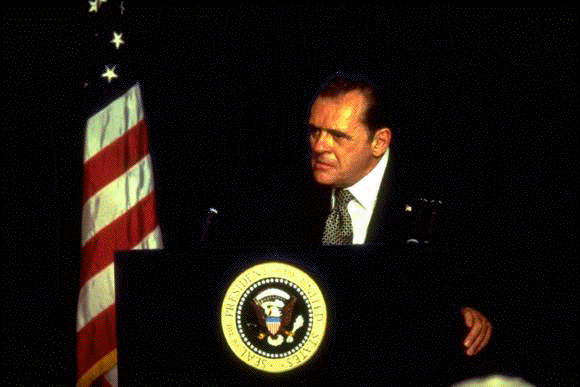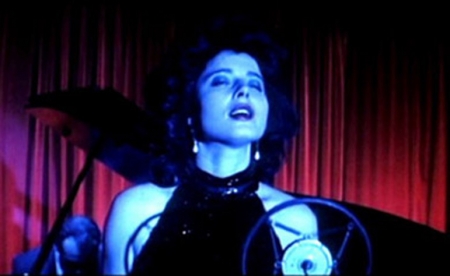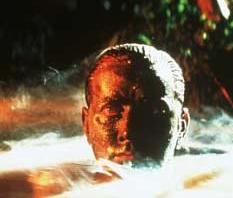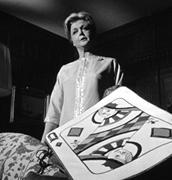For
years, decades even, screenwriting students have been warned off
flashbacks and dream sequences. If you have to stick one of those
in, intone the gurus, then your script has got problems.
But does it? Especially if you’re trying to tell a
story that is much more than a story. What if your story is a fable
or a summation or an indictment? What if you’re trying to
say something about an idea or ideal that escapes rationale thought
and the three act narrative?
Next year is an election year, perhaps the most important one in
the last hundred years. 2008 will mark two unbelievable milestones
– the death of The Reagan Fantasy and the re-birth of The
Sixties. In that light, George W. Bush had to serve two terms; there
was no other way to strip bare, at long last, the profoundly awful
nature of neo-conservatism while convincing the American public
that the idealistic yearnings of the boomers might have some real
value as the basis of a social safety net.
Indeed, I can think of a number of films in which dream sequences
articulate compelling political arguments. Consider, for example,
Oliver  Stone’s
Nixon. (1995). Stone, until this film, had struggled to
say what he wanted to say about the sixties. With Nixon,
he found just the right vehicle. The wild aesthetic style that muddied
the waters of JFK seemed perfectly suited to the paranoia
and boozy ruthlessness of Tricky Dick. Yet the film is hardly a
condemnation of Nixon. For Stone, Nixon was a tragic figure cursed
with unique access to ugly truths, an ill-suited voyager into the
deep black heart of mid-century America. The whole film has a strange
dream-like quality to it, in which sound and picture converge and
diverge with Nixon’s minor key emotional fugue of sentimentality,
regret, resentment and drive. As the great existential psychiatrist
Irvin Yalom observed, a nightmare is a failed dream. At one point
in the film, Nixon awakes in the middle of night to visit the Lincoln
Memorial where a student protest is going on. Nixon confronts a
young woman who takes one look at her president and realizes that
there’s little he can do to stop The System. Nixon remarks
with grim awe to his driver that the girl has just said what it
took him thirty years in politics to learn. The film is less a movie
than the representation of one man’s swamp of subjectivity
as he blunders through the engine room of the American Dream. And
that man was Richard M. Nixon. Stone’s
Nixon. (1995). Stone, until this film, had struggled to
say what he wanted to say about the sixties. With Nixon,
he found just the right vehicle. The wild aesthetic style that muddied
the waters of JFK seemed perfectly suited to the paranoia
and boozy ruthlessness of Tricky Dick. Yet the film is hardly a
condemnation of Nixon. For Stone, Nixon was a tragic figure cursed
with unique access to ugly truths, an ill-suited voyager into the
deep black heart of mid-century America. The whole film has a strange
dream-like quality to it, in which sound and picture converge and
diverge with Nixon’s minor key emotional fugue of sentimentality,
regret, resentment and drive. As the great existential psychiatrist
Irvin Yalom observed, a nightmare is a failed dream. At one point
in the film, Nixon awakes in the middle of night to visit the Lincoln
Memorial where a student protest is going on. Nixon confronts a
young woman who takes one look at her president and realizes that
there’s little he can do to stop The System. Nixon remarks
with grim awe to his driver that the girl has just said what it
took him thirty years in politics to learn. The film is less a movie
than the representation of one man’s swamp of subjectivity
as he blunders through the engine room of the American Dream. And
that man was Richard M. Nixon.
Nobody knows more about nightmares than David Lynch. For
Lynch, reality is an unstable entity that at any moment can disappear
into the night where trouble so often awaits. Characters
seem to be drifting at  the
edge of consciousness yet are unprepared for the inevitable. Rooms
thrum loudly and guitars sound like buzzsaws. But in only one of
his films, Blue Velvet (1986), does he manage to make his
special aesthetic devices and thematic obsessions echo out into
history, very recent history. The story is deceptively trite, a
Trojan Horse really. It is set in a small town. A clean-cut young
man, Jeffrey, home from college to help out at the hardware store
owned by his ailing father, finds a severed human ear in a field.
He takes the ear to a detective whose daughter, Sandy, happens to
be a blond bobbysoxer goddess. The two kids begin their own investigation;
it takes them to the bad side of town where people like a distressed
torch singer and the psychotic thug who lusts after her thrive. the
edge of consciousness yet are unprepared for the inevitable. Rooms
thrum loudly and guitars sound like buzzsaws. But in only one of
his films, Blue Velvet (1986), does he manage to make his
special aesthetic devices and thematic obsessions echo out into
history, very recent history. The story is deceptively trite, a
Trojan Horse really. It is set in a small town. A clean-cut young
man, Jeffrey, home from college to help out at the hardware store
owned by his ailing father, finds a severed human ear in a field.
He takes the ear to a detective whose daughter, Sandy, happens to
be a blond bobbysoxer goddess. The two kids begin their own investigation;
it takes them to the bad side of town where people like a distressed
torch singer and the psychotic thug who lusts after her thrive.
The film has the usual Lynch doppelgangers who threaten to merge
at some key point in the film. Jeffrey and Frank Booth, the psycho,
are two sides of the same coin. And it is the coin of the realm
of Ronald Reagan. Dutch came into power in part to banish the sixties
and all its attendant fantasies of free love and social justice
that had gone rancid in the wake of Watergate and Jonestown. Instead,
with Reagan at the helm, America would return to it rightful place,
dab smack in the middle of a Norman Rockwell painting. But the Frank
Booths of America never go away. They embrace anger and violence
and lust as birthrights and they take what they want any way they
can for as long as they can. The dream sequences in Blue Velvet
belong to Jeffrey who is seeing things that have been hidden to
him but now are revealed. They are deeply troubling yet strangely
appealing. They cannot be banished or ignored or erased because
they belong to America. The film has a patently false ending that
seems entirely unsustainable. Lynch, the twisted boy scout dweeb,
perhaps hopes that the sun shines on mechanical robins but knows
that it can’t for long. The shining city on the hill casts
long shadows as the sun goes down.
Perhaps the most famous dream sequence in American cinema
is one that was originally shelved. In his conversations
with Canadian author Michael Ondaatje, Walter Murch reveals that
when he and Francis Ford Coppola were cutting Apocalypse Now,
they could never figure out how  to
get into and get out of a sequence in which the boat’s crew
happen upon a plantation populated by a rich French family and their
guards. Of course, as the sequence progresses, we realize that we
are watching ghosts, that the crew has entered into a collective
dream, borne of fear, ignorance and grief. What the plantation sequence,
a gorgeous haunting reverie, provides is historical context. The
French left Vietnam when the getting was good and never looked back.
America is still dealing with the psychic fallout of its bleak misadventure
in the muggy jungles of Southeast Asia selling democracy where the
market was non-existent. We are in Iraq because we were in Vietnam.
The wisdom of the ghosts still falls on the deaf ears of messianic
chickenhawks. to
get into and get out of a sequence in which the boat’s crew
happen upon a plantation populated by a rich French family and their
guards. Of course, as the sequence progresses, we realize that we
are watching ghosts, that the crew has entered into a collective
dream, borne of fear, ignorance and grief. What the plantation sequence,
a gorgeous haunting reverie, provides is historical context. The
French left Vietnam when the getting was good and never looked back.
America is still dealing with the psychic fallout of its bleak misadventure
in the muggy jungles of Southeast Asia selling democracy where the
market was non-existent. We are in Iraq because we were in Vietnam.
The wisdom of the ghosts still falls on the deaf ears of messianic
chickenhawks.
In the Manchurian Candidate, a platoon of soldiers on patrol
in Korea is brainwashed. They return to the United States where
they all share the same nightmare. One of them has been given a
special gift; he is programmed as an assassin, cued by a face card.
The film is rightly celebrated for its psychological complexity
but the dream sequences are hardly arresting. Far more compelling is the opening of Sidney Lumet’s
Cold War thriller, Fail-Safe (1964). A matador is about
to slaughter a bull in the ring. The black and white film stock
burns with irradiation. This nightmare belongs to a sullen colonel
who is good friends with the President, played by Henry Fonda. A
computer glitch sets off a number of irreversible circumstances
that eventually lead to the accidental nuking of Moscow. In order
to avoid nuclear war, the President sacrifices New York. He sends
his buddy, the colonel, to complete the mission. Just as he’s
dropping the bomb, the colonel commits suicide, whispering, “the
matador, the matador, the matador, me, me.” Was this the nightmare
of one man or of an entire country, in the ring of geo-politics,
waiting for the moment of truth.
hardly arresting. Far more compelling is the opening of Sidney Lumet’s
Cold War thriller, Fail-Safe (1964). A matador is about
to slaughter a bull in the ring. The black and white film stock
burns with irradiation. This nightmare belongs to a sullen colonel
who is good friends with the President, played by Henry Fonda. A
computer glitch sets off a number of irreversible circumstances
that eventually lead to the accidental nuking of Moscow. In order
to avoid nuclear war, the President sacrifices New York. He sends
his buddy, the colonel, to complete the mission. Just as he’s
dropping the bomb, the colonel commits suicide, whispering, “the
matador, the matador, the matador, me, me.” Was this the nightmare
of one man or of an entire country, in the ring of geo-politics,
waiting for the moment of truth.
--
Timothy Dugdale
Timothy Dugdale teaches in the Department of English at the
University of Detroit Mercy.
|






